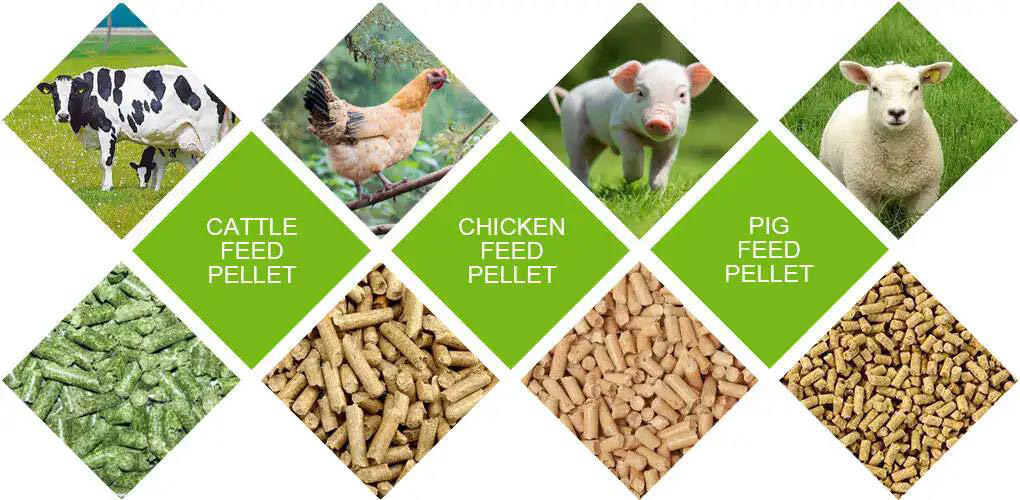Livestock feed pellet mill
A Livestock feed pellet mill is a specialized device used to grind livestock feed pellets into powder. It plays a crucial role in the processing of livestock feed
Livestock feed pellet mill Introduction
A Livestock feed pellet mill is a specialized device used to grind livestock feed pellets into powder. It plays a crucial role in the processing of livestock feed, grinding various components of feed pellets into a powder suitable for consumption by livestock, thereby enhancing feed digestion, absorption rates, and utilization.


Features of Livestock feed pellet mill
Versatility
It can adapt to different types and formulations of livestock feed, meeting the nutritional needs of various types of livestock.
High crushing efficiency
It has efficient crushing ability and can quickly grind feed pellets into powder.
Adjustable particle size
The particle size after grinding can be adjusted to meet the digestion and absorption needs of different livestock.
Sturdy and durable
Made of wear-resistant materials, it has a strong structure and a long-term stable service life.
Easy operation
Simple design, easy to operate and maintain, operators can easily master it.
High safety
Equipped with safety protection devices to ensure the safety of operators.
Environmentally friendly and energy-saving
It adopts energy-saving design, reduces energy consumption, and minimizes environmental pollution.
High production efficiency
Easy operation and high crushing efficiency can meet the large-scale demand for livestock feed production.


Structure of Livestock feed pellet mill
Feeding System
This part is responsible for delivering the raw materials into the grinding chamber. It usually consists of a hopper or feeder mechanism.
Grinding Chamber
This is the core component where the grinding process takes place. It houses the grinding mechanism that breaks down the feed pellets into powder.
Grinding Mechanism
The grinding mechanism could vary depending on the design of the mill. It may include grinding discs, rollers, or hammers, which are responsible for grinding the feed pellets.
Screening System
This system controls the particle size of the ground feed powder. It typically includes a sieve or mesh to separate the powder particles based on size.
Discharge System
Once the grinding process is complete, the ground feed powder needs to be discharged from the mill. This system consists of a discharge port or conveyor mechanism.
Power System
The mill requires a power source to operate its grinding mechanism. This could be an electric motor, diesel engine, or other power sources.
Control System
Some advanced models may include a control system that allows operators to adjust various parameters such as feed rate, grinding speed, and particle size, to optimize the milling process.
Cooling System
In some cases, especially for high-capacity mills, a cooling system may be integrated to prevent overheating of the grinding mechanism during prolonged operation.


Advantages of Livestock feed pellet mill
Improved Feed Utilization
Grinding feed pellets into powder increases their surface area, aiding better digestion and absorption of nutrients by livestock, thus reducing feed wastage.
Enhanced Feed Uniformity
The mill grinds feed into a uniform powder, ensuring even distribution of various nutrients in the feed, thereby ensuring balanced nutrition for livestock.
Strong Adaptability
It can handle different types and formulations of livestock feed, meeting the nutritional needs of various livestock.
Improved Feed Quality
Grinding process removes large particles and impurities from the feed, enhancing its purity and quality.
Enhanced Livestock Health
Finer, more uniform feed powder aids better digestion and nutrient absorption, reducing the occurrence of digestive issues and diseases in livestock.
Ease of Operation
Modern mills are designed for simple operation and maintenance, making it easy for operators to handle.
Cost Savings
Improved feed utilization and quality reduce feed wastage, thus lowering feed costs.
Environmental Friendliness and Energy Efficiency
Adoption of energy-saving designs reduces energy consumption and environmental pollution.
High Production Efficiency
With efficient grinding capability and automation, it can meet the demands of large-scale livestock feed production.
Application of Livestock feed pellet mill
Typically, the production of feed pellet mill uses raw materials such as corn, soybeans, wheat, and other nutrients as the formula. Our feed pellet mill are specially used to produce feed for poultry, livestock, pigs, horses, cattle, sheep, chickens, ducks, goose and other animals.For different animals, with different growth cycles, (chicks, suckling pigs, calves, etc.), the feed pellet size required is different, but our feed production line only needs to replace ring molds with different apertures or use a pellet crumbler to reach the required size.

Parameter of Livestock feed pellet mill
| Model | Capacity | Main Motor Power | Feeder Motor Power | Conditioner Power | Dia. of Ring Die | Pellet Size |
| SZLH250 | 1-2T/H | 22KW | 0.75kw | 1.5kw | 250mm | 2-12mm |
| SZLH320 | 3-4T/H | 37KW | 1.5kw | 2.2kw | 320mm | 2-12mm |
| SZLH350 | 5-7T/H | 55KW | 1.5kw | 3kw | 350mm | 2-12mm |
| SZLH420 | 8-12T/H | 110KW | 1.5kw | 7.5kw | 420mm | 2-12mm |
| SZLH508 | 10-18T/H | 160KW | 2.2kw | 11kw | 508mm | 2-12mm |
| SZLH558 | 15-25T/H | 180KW | 2.2kw | 11kw | 558mm | 2-12mm |
| SZLH678 | 20-30T/H | 220KW | 2.2kw | 11kw | 678mm | 2-12mm |
| SZLH768 | 25-42T/H | 280KW | 2.2kw | 11kw | 768mm | 2-12mm |







